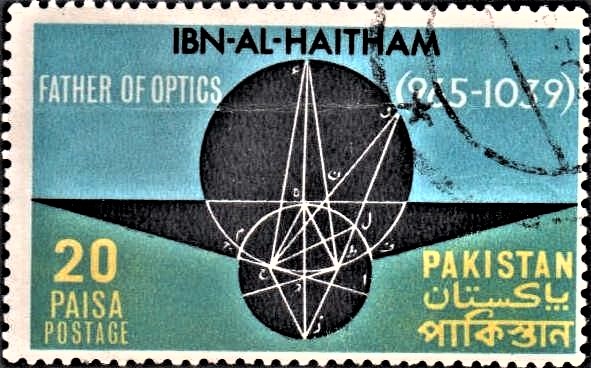
Ibn-al-Haitham
A commemorative postage stamp on the 1000th Anniversary of Ibn al–Haytham (Alhazen), Father of Optics (965–1039) :
 Issued by Pakistan
Issued by Pakistan
Issued on Nov 4, 1969
Issued for : To salute the memory of Abu Ali Al Hasan ibnul Hasan ibn al-Haitham (Alhazen) and the monumental achievements bequeathed by him to mankind, the Pakistan Post Office is issuing a commemorative postage stamp of 20 Paisa denomination on 4th November, 1969 on the occasion of the celebration of the 1000th Anniversary under the auspices of Hamdard National Foundation.
Design : The stamp is rectangular and horizontal in format. It is divided into two portions by the diagram indicating reflection of light drawn by Ibn-al-Haitham, the father of optics. This diagram joins the main part of the design and is in black colour with markings in reverse. The words “IBN–AL–HAITHAM” appear in black above the diagram, against the blue upper portion of the stamp. The words “FATHER OF OPTICS” and the period “(965-1039)” appear in reverse on either side of the diagram. The lower portion of the stamp is green with the denomination figure, the words “PAISA”, “POSTAGE” and “PAKISTAN” (in English, Urdu and Bengali) in yellow on either side of the diagram.
Type : Stamp, Postal Used
Denomination : 20 Paisa
Colour : Blue, black, yellow and one extra colour in green in the lower panel has been formed by combination of blue and yellow operations.
Size of stamp : 49.2 x 30.7 mm.
Size of print : 46.2 x 27.7 mm.
Perforation gauge : 13 x 13 (c)
Quantity printed : 15,00,000
Number of stamps in each sheet : 50
Process of printing : Photogravure
Printers : The Pakistan Security Printing Corporation Ltd., Karachi
Name : Abū ʿAlī al–Ḥasan ibn al–Ḥasan ibn al–Haytham
Born on Jul 1, 965 at Basra, Buyid Emirate [now in Iraq]
Died on Mar 6, 1040 at Cairo, Fatimid Caliphate [now in Egypt]
About :
- Science, has no country. It is international; we all share in the fruits of the investigations of all people, of all kinds and traditions and of all ages.
- The early following of the human intellect was around the shores of the Mediterranean. Sumer, Babylon, and Egyptian civilisations gave way to the Greek. When this declined there was danger of breaking of the continuity of understanding of natural phenomena, but fortunately for all mankind it was picked up by the great Muslim scholars of the 8th-13th centuries. They strengthened and enriched it with their own profound wisdom, keen observation and experiments and passed it on to the West.
- The names of these Arab scholars is legion: Al–Kindi, Rhazes, Jabir, Haly Abbas, Albiruni, Avecenna, Abulcasis, Al–Farabi, Alhazen are prominent figures in the phalanx of the universally learned Muslim scholars who characterize the golden age of Islamic science.
- In this year of grace, when man has first set foot on the moon and is reaching out to other heavens, it is salutary to remember and acknowledge the great debt that modern science and technology owes to the patient and exacting work of the early pioneers. This year we celebrate the 1000th Anniversary of one of the greatest of them, Abu Ali al-Hasan ibnul Hasan ibn al-Haitham who according to George Sarton, the American historian of science, is “the greatest Muslim physicist and one of the greatest students of all times”. Alhazen was a man of many parts – astronomer, mathematician, physicist and physician. He had a 20th century mind in a 10th century setting and his contributions to knowledge, especially optics, were quite extraordinary.
- Ibn–al–Haitham was born in Basra in 965. After his education, he moved to Cairo which was then the hub of the Islamic world and a great centre of learning. His reputation as an outstanding mathematician and engineer excited the curiosity of the Fatimid Caliph, Al–Hakim, who after having met him, took him into his service. Ibn-al-Haitham was held in high esteem by al-Hakim for sometime. The River Nile in its annual inundation used to cause devastation of life and property. Alhazen proposed a plan for building a dam on the destructive river. But this ambitious scheme became impracticable and Ibn-al-Haitham fled from the caliph’s wrath and its consequences and simulated madness until al-Hakim’s death. His dream and vision came true when the Aswan Dam was built by the Egyptian government a thousand years later. This period of hiding and simulated madness however proved very fertile and ingenious. He copied many ancient treaties on mathematics and physics and himself composed many works on these subjects and on medicine which was his original profession. He returned to Cairo after al-Hakim’s death with rare accomplishments and gave to the world, a vast wealth of wisdom and knowledge.
- His greatest work is “On Optics” or the Kitabul Manazir; the original book in Arabic is lost, but the book survives in Latin. In it Ibn-al-Haitham explodes the theory of Euclid and Ptolemy that the eye sends out visual rays to the object of vision. He states that “it is not a ray that leaves the eye and meets the object, that gives rise to vision. Rather the form of the perceived object passes into the eye and is transmitted by its transparent body (i.e. the lens). Although most of his successors did not adopt his theory of vision, not did the oculists of later periods of Islamic science, Al-biruni and Avicenna however shared fully and independently his opinion. Ibn-al-Haitham also discussed the propagation of light and colours, optic illusions and reflection, with experiments for testing the angels of incidence and reflection. His name is still associated with the so-called “Alhazen’s problem” : “In a spherical concave or convex, a cylindrical or conical mirror, to find the point from which an object of given position will be reflected to an eye of given position”. It leads to an equation of the fourth degree which Alhazen solved by the use of hyperbola which has won the admiration of the entire world of science.
- The refraction of light rays has been examined by Alhazen through transparent mediums such as air and water. Theoretically he had almost discovered magnifying lenses through his experiments through spherical segments (glass vessels filled with water). These lenses came into existence in Italy three centuries later, whilst more than six centuries were to pass before the law of sines was established by Snell and Descartes. Alhazen’s optical thesaurus forms the basis of the optical works of such great Western writers as Roger Bacon, the Pole Witelo. His influence on Leonardo da Vinci, Johana Kepler and the great Sir Issac Newton is well-known.
- Besides this most celebrated book on optics, the great Arab scholar wrote no fewer than 44 treatises on philosophy, geometry, astronomy and mechanics. In his treatise on the Twilight Phenomena which is extant only in Latin, he maintains that this atmosphere is about 10 miles in height. His other works deal with the rainbow, the halo, the spherical and parabolic mirrors. These and some other books on shadows and eclipses are of a highly mathematical character. He puts his calculations into practice by constructing such mirrors of metal. The bulk of his works were produced in the last decade of his life. His fundamental study “on the Burning Glass” in which he created a dioptric was far superior to that of the Greeks. This work shows the profundity and accuracy of his conception of the nature of focussing, magnifying, inversion of the image and formation of rings and colours by experiments. He wrote a commentary on the optical works of Euclid and Ptolemy, on the “Physics” of Aristotle and on the Aristotelian Problemata. He observed the semi-lunar shape of the image of the sun during eclipses on a well opposite a fine-hole made in the window-shutters – the first record of the camera obscura.
- In his book called the Balance of Wisdom he discussed dynamical principles, generally supposed to be the monopoly of modern science. He described minutely the connection between the weight of the atmosphere and its density, and how material objects vary in weight in a rate and in a dense atmosphere. He discussed the submergence of floating bodies, and the force with which they rise to the surface when immersed in light or heavy media; he fully understood the principle of gravitation, and recognised gravity as a force. He knew correctly the relation between the velocities, spaces, and times of falling bodies, and had very distinct ideas of capillary attraction.
- Ibn-al-Haitham died about 1039 A.D. The translation of his historic book Kitabul Manazir was first undertaken by Risner in 1543. Before this a commentary on Kitabul Manazir was written by Kamaluddin Farsi in 1320. This book named “Tanqueeh–ul–Manazir” is in two thick volumes.
- Ibn-al-Haitham tolerated no philosophical aloofness. His enormous intellectual effort led the way in optics on the one hand and designed the bridge across the Nile on the other. He has left a legacy for all nations – a lively interest in the promotion and sharing of scientific knowledge.
- The treasure of Islamic science have begun to be opened. During the last few years the mass of material recovered from the libraries in Constantinople, Cairo, Damascus, Mosul, Baghdad, in Iran and India and in the Escorial Library in Spain, has gone far to subvert our former conceptions and has thrown a flood of light on the history of scientific thought in the Islamic World.
- Today there are signs of a new understanding of the East. As this knowledge spreads and the East recovers its rightful place in the life of humanity, oriental literature, art and science may once again perform their historic functions and assist us to liberate ourselves from the narrow and oppressive conceptions which would limit all that is significant in literature, thought and history to any one small segment of the globe.
- The celebration of the Millenary of Ibn-al-Haitham under the auspices of Hamdard National Foundation Pakistan serves to remind us of the humility with which we should view our own achievements, for they would be as nothing had we not the contributions of the past to guide us. We are justly reminded that the present is short, the past is long and that to advance in the future, we must keep the past well in mind. No revivalist movement has ever brought back the past, nor will this celebration of the Millenary of one of the illustrious men of the past the man who laid the corner-stone of science, but it can take and adapt old ideas of the past. That is not however the chief benefit that can be got from this renewed interest in Ibn-al-Haitham. It may not contribute a single artistic motif, or mechanical device, or scientific concept, but it must inevitably break down much narrowness, enlarge the sympathies, and fire ambitious by bringing into contact with greatness that is not less great for not being modern.
- [Write-up contributed by Hakim Mohammed Said].
- Issued by the Director-General, Pakistan Post Office, Karachi.


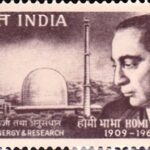
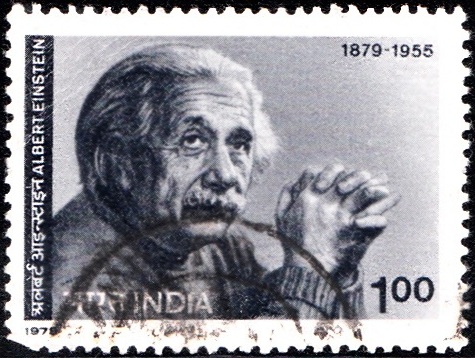

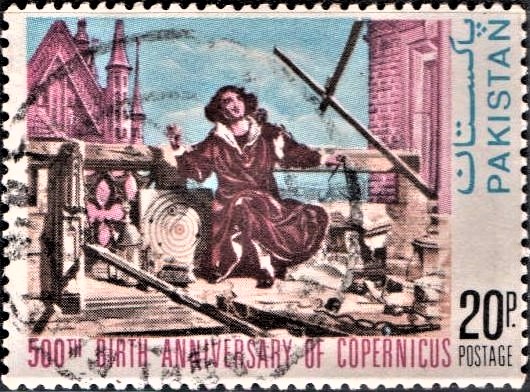

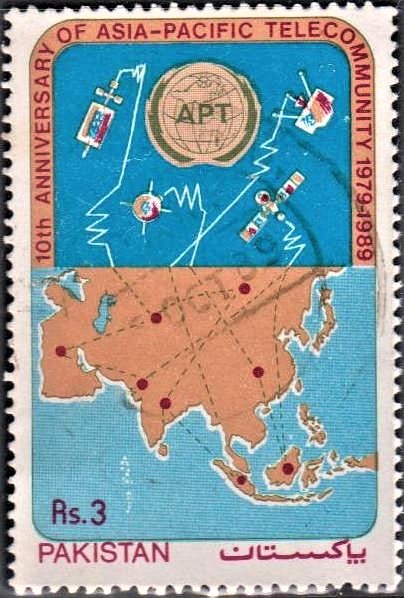
[…] Euclid, Zeno, Ptolemy, Al–Farabi, Al–Khayyam, Al–Razi, Al–Khawarazmi, Al–Haitham, Al–Biruni, Al–Khazin, Thabit bin Qurrah, Al–Battani, Aryabhata, Bhojadeva, […]